Astrology and the psyche
The field of psychological astrology is well recognised today, with psychologists using astrology and astrologers training in psychotherapy and counselling to better support clients. Astrology is used to help therapists make their way past clients’ blind spots and defences and peer into the psyche; the hidden, unconscious self behind what is presented. Astrology also provides perspective and insight as therapists tread carefully through the minefields created by projection and transference. “I must say,” said Carl Jung in later life, “that I very often found that the astrological data elucidated certain points, which I otherwise would have been unable to understand.”
Psyche and soul
Until the 19th century, the psyche was known as the soul, or life force. In his famous treatise, On the Soul, Aristotle examined the role of the soul in the human, describing it as the human essence. Aristotle believed that because the human soul has the capacity for intellect, it’s raised higher than that of the animals.
Descartes held that thinking is essential to soul and self, and from this drew the conclusion that animals have no souls as they do not think. Today, both these hypotheses are linked to the psyche, rather than the modern belief of the soul as an immaterial being that lives on after death.
Understanding which element is dominant in your astrology chart helps you understand yourself and how you respond to the world.
With free thought comes the responsibility to manage and control your psyche; to stop the psyche getting out of control and causing you to act rashly or irrationally. How can you understand how your psyche functions? And how can you develop the awareness to make decisions from a place of “response-ability” rather than “re-act”?
Psychology attempts to answer those questions and its recent beginnings were closely linked with astrology through the work of Carl Jung. However, astrology and the human urge to explore the psyche have been related for centuries. Ancient Egyptians, Greeks and Arabs drew links between the macrocosm and microcosm, likening internal human drives to the movements of the heavens.
What is below is like what is above.
And what is above is like what is below,
so that the miracle of the One may be accomplished
This excerpt, from a translation of the Emerald Tablet, written by a legendary Egyptian sage, describes how events on Earth mirror those in the stars, which themselves are directed according to a universal plan. If you can understand those movements, human purpose, along with the part each individual plays in it, can be understood. Such a concept inspired scholars such as Socrates, Plato and Aristotle to use astrology to gain insight into this plan and its mechanisms.
The Renaissance, Ficino and Melancholy
The Renaissance saw further study of the links between astrology and the psyche. Marsilio Ficino, one of the great Florentine Renaissance figures, spoke of the planets as carrying divine authority, which man could connect to and gain understanding from by acting from the infinite part of his soul. Ficino said that astrology “could… only be justified if it provided some means or guidance for the human soul to begin to know itself in the image of God”.
In 1621, in England, scholar Robert Burton released a huge tome called The Anatomy of Melancholy, an exploration of the illness of melancholy. Burton described melancholy as “so universal a malady, an epidemical disease, that so often, so much, crucifies the body and mind”. He saw the placements of the stars at birth as instrumental in this disease and made detailed observations linking specific astrological placements to mental illnesses, including “general melancholia”, “love madness” and “lunacy”.
Alan Leo and the Sun
It was in the late 1800s, under Alan Leo, that the idea of “what is without is also within” came to the fore. Leo believed willpower was drawn from the stars and that this energy could be harnessed consciously for personal development and to help you rise above your psyche. Leo thought that not only would you experience events that could be predicted by astrology, but those events would go on to shape and mould your character. From Leo’s perspective, astrology could give insight into the flavour of these changes.
Leo saw that intellect and free will offered a chance for personal development, which he noted in saying “the wise man rules his stars while the fool obeys them”. Believing that the “rays of the sun” carry with them intelligence from a supreme being, Alan Leo focused on the Sun as a marker of personality traits. From his emphasis on the Sun arose the Sun sign astrology that characterises the field today.
Carl Jung
A few decades later, through the work of Carl Jung, one of modern psychology’s forefathers, astrology became inextricably woven into the growth and development of psychology. When researching theories on the influence of archetypes and the collective unconscious on the psyche, Jung explored the occult, which led him to astrology. He began to use astrology in his early practice to assist with understanding clients’ unconscious drives. The positive results of this work had him studying and working with astrology for more than 30 years.
What is below is like what is above.
And what is above is like what is below,
so that the miracle of the One may be accomplished.
Letters in 1911 between Jung and his mentor, Sigmund Freud, show Jung created charts for his clients “to find a clue to the psychological truth” and sharing that he found that “the signs of the zodiac are character pictures” that could help offer insights he couldn’t glean from clients’ stories alone, or would take much time to discover. Freud’s reply at the time supported Jung’s astrological explorations, saying he was “willing to believe anything that can be made to sound reasonable”. However, it was only a few years later that they had their famous falling out over the theory of libido and Jung’s relationship with the occult.
Jung and Freud also differed in their views on personality. Freud believed a child is born as a blank slate and is completely shaped by life experience until the age of six. Jung believed that personality is inherent and imprinted at birth and is then modified by life experiences. Psychological astrology also holds this view. It uses your natal (birth) chart as a tool to understand your innate nature.
Four element theory
The four elements that are the basis of astrology — fire, earth, air and water — formed the basis of Jung’s theory of the four psychological types. He saw the elements as describing how humans perceive the world. Jung called them the thinking function (air), the feeling function (water), the sensation (earth) and intuition (fire).
Understanding which element is dominant in your astrology chart helps you understand yourself and how you respond to the world. Those with strong fire are doers, meeting the world with passionate energy and acting from their intuition. Those with earth are about stability, being practical and grounded, often sensing their way into life with their hands. Airy people are more objective, logical and rational, with thinking and the mind being their main drivers. And, finally, those with water dominant feel their way through life with the grace of emotion, nurturance and perception. Water is open to the unconscious side of life.
Elements and psychological types
| Element | Psychological Type | Quality |
| Fire | Intuition | Active |
| Earth | Sensation | Stable |
| Air | Thinking | Logical |
| Water | Feeling | Sensitive |
Most psychologists, or astrologers for that matter, will tell you they build a stronger relationship with their client by carefully matching their language and responses to those of their client to encourage safety and connection. Knowing which element is stronger in a client’s chart, or even which element communication planet Mercury is placed in, makes this matching tool easier for therapists to access. It supports a genuine understanding experience for the client.
Four element theory also helps therapists better understand what might be important for a client, including how they may view and respond to life events. For example, when witnessing a car accident, fire would rush into action, administering first aid or moving the injured out of danger. Air would call emergency services and then act as a witness when they arrive. Water would be found sitting with the victims to ensure they feel calm. Earth would busy themselves with practical tasks such as making sure passersby keep away and directing traffic around the accident.
Jung believed balancing the element functions to an equal level of perception was an important aim of personal development work and was a means to achieve wholeness. Four element theory is a way to work with clients to help clarify the strengths of their dominant element and build up other parts of perception. Jung later wrote, “Obviously astrology has much to offer psychology, but what the latter can offer its elder sister is less evident. So far as I judge, it would seem to me advantageous for astrology to take the existence of psychology into account; above all, the psychology of the personality and of the unconscious.”
Synchronicity and spirit
Jung also put much stock in the idea of synchronicity, where related events occur at the same time but one does not cause the other. He saw this as a result of the interconnected nature of the universe. Synchronicity is at play in experiences like when you read something that sets off a light bulb moment and then someone calls you soon after to talk about exactly that thing, leaving you wondering what is going on. You know it’s more than co-incidence.
Synchronicity is how Jung saw links between the psyche and astrology at work. Jung believed the connection between the pattern of planets at birth and a client’s personality occurs because of synchronicity and unconscious projection — not because one caused the other. Liz Greene, an astrologer and Jungian psychologist, extends this idea further saying, “The positions of the heavens at a particular moment in time, by reflecting the qualities of that moment, also reflect the qualities of anything born at that moment … One does not cause the other; they are synchronous and mirror each other.”
If Jung’s work led to a resurgence in astrology, then Dane Rudhyar, the 1960s pioneer of humanistic astrology, built on his foundations to take astrology to the general public. Rudhyar learnt astrology at the same time he was studying Jung’s philosophies and was inspired by the idea of bringing the two together.
Astrology offers a chance to align your outer life with your innate, inner essence, gaining a clearer perspective of your core self and purpose
Rudhyar agreed with Jung’s idea of synchronicity and the natal chart. He saw the stars and planets as psychological forces working in human lives, which do not override freedom of choice but instead are “the blue-print of the process of individuation for this particular individual”. Like many earlier astrologers, he believed that understanding your natal chart and its evolution in relation to the continuing movement of the planets was necessary to become conscious and whole. He also saw this as the way to activate the true, spiritual self.
Rudhyar also believed astrology was more than just predicting events. He saw that it offered a way to understand yourself and to hold a positive self-picture that could support you in consciously absorbing and learning from life circumstances. In this way you can reduce the development of unconscious psychoses that conflict with your conscious stated purpose, instead moving towards wholeness and fulfilling your potential. For Rudhyar, a holistic approach to astrology was key to leading a spiritual life, as he believed that only when you are whole can the spirit grow and evolve.
Steven Forrest, a respected modern astrologer, considers understanding and awareness of the psyche and personality as the main purpose of astrology. He believes the natal chart shows an ideal form of self that is set deep within you at the moment of birth and needs to be reflected by the psyche to have peace of mind.
Life stages
Developmental psychology is another field of psychology that astrology connects to, especially theories such as Erik Erikson’s Life Stage Development. As the planets continue to move after birth, they form aspects back to the place they occupied at birth, indicating important windows of opportunity for development and growth.
One well-known example is Saturn and its cycle. Saturn takes around 29 years to return to its original position. Liz Greene describes Saturn’s cycle as a process of the psyche that, through the experience of restriction, responsibility and discipline, enables you to reach “for greater consciousness and fulfilment”.
In Saturn’s cycle, the initial opposition aspect occurs around the age of 14. This brings the first chance to reflect on your formation so far, especially through the influences of parents, friends and society. It is no coincidence that psychology has noticed a crisis of consciousness at this same life stage. It occurs when forming an independent self, often taking the form of challenging and testing, well known to any parents of teenagers. This is due to the development of critical evaluation skills, which allows adolescents to look at family and social patterns and question what they will take forward into their life.
Then, at 29 years, after a time of testing and experimenting with possible paths and identities, your new self forms through yet another crisis point, one which encourages conscious choice of direction. This is the Saturn Return, with all its resulting challenges and restructuring.
Saturn’s cycle and life stages
| Cycles | Ages | |||
| First or waxing square: crisis in progress | Opposition: re-evaluating commitments | Third or waning square: reorientation | Conjunction: endings and beginnings | |
| First cycle | 7 | 14 | 21 | 28–30 |
| Second cycle | 35–37 | 42–44 | 49–51 | 56–58 |
| Third cycle | 63–65 | 70–72 | 77–79 | 84–86 |
Astrologer and psychotherapist Glenn Perry characterises psychological astrology as “both a personality theory and a diagnostic tool”. He sees many benefits in using astrology to both build empathy for clients and enhance the therapist’s ability to effectively treat psychological problems.
Perry also describes the natal chart as “an evolving story that reflects a process of growth over time”, in which astrological cycles can highlight events to offer a chance for development and growth when explored in a therapeutic setting. This process examines your life script. It encourages self-understanding via the metaphor of story, much the same as narrative therapy. It also allows a more complex and individual understanding of self, rather than the fixed and simplistic views on personality and psyche that both psychology and astrology can create.
Astrology offers a chance to align your outer life with your innate, inner essence, gaining a clearer perspective of your core self and purpose. Today, with astrology and psychology working together, you are offered an even greater chance of taking personal responsibility by creating self-awareness.








